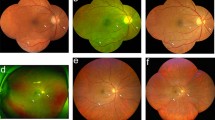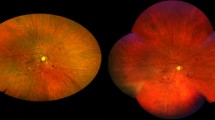Abstract
For decades, the standard method for screening and grading severity of diabetic retinal disease has relied upon a montage of photographs using normal angle fundus cameras. With the development of ultrawide field (UWF) fundus imaging, more of the retina can be imaged with fewer pictures, less dependence on photographer skill, and, often, greater ease on the patient. Recent studies have shown comparability between traditional and UWF imaging for standard grading of diabetic retinopathy. Moreover, UWF images can detect peripheral pathology not typically seen in standard photographs, which may enlighten our understanding of disease severity and suggest new indications for treatment.

Similar content being viewed by others
References
Papers of particular interest, published recently, have been highlighted as: • Of importance •• Of major importance
Diabetic Retinopathy Study Research Group: design methods and baseline results. DRS report no. 6. Investig Ophthalmol. 1991;21:149–209.
Early Treatment Diabetic Retinopathy Study Research Group. Grading diabetic retinopathy from stereoscopic color fundus photographs—an extension of the modified Airlie House classification (ETDRS report number 10). Ophthalmology. 1991;98:786–806.
Hubbard LD, Sun W, Cleary PA, et al. Comparison of digital and film grading of diabetic retinopathy severity in the diabetes control and complications trial/epidemiology of diabetes interventions and complications study. Arch Ophthalmol. 2011;129:718–26.
Gangaputra S, Almukhtar T, Glassman AR, et al. Comparison of film and digital fundus photographs in eyes of individuals with diabetes mellitus. Invest Ophthalmol Vis Sci. 2011;52:6168–73.
Li HK, Danis RP, Hubbard LD, Florez-Arango JF, Esquivel A, Krupinski EA. Comparability of digital photography to the ETDRS film protocol for evaluation of diabetic retinopathy severity. Invest Ophthalmol Vis Sci. 2011;52:4717–25.
Silva PS, Cavallerano JD, Sun JK, Soliman AZ, Aiello LM, Aiello LP. Peripheral lesions identified by mydriatic ultrawide field imaging: distribution and potential impact on diabetic retinopathy severity. Ophthalmology. 2013;120:2587–95. This study validates that UWF images can be used for DR severity grading and, moreover, suggests that lesions observed outside the 7SF may influence DR severity level.
Early Treatment Diabetic Retinopathy Study Research Group. Fundus photographic risk factors for progression of diabetic retinopathy: ETDRS reports number 12. Ophthalmology. 1991;98:823–33.
Ciardella A, Brown D. Wide-field imaging. In: Agarwal A, editor. Fundus fluorescein and indocyanine green angiography: a textbook and atlas. Thorofare: Slack Inc; 2007. p. 79–84.
Witmer M, Kiss S. Wide-field imaging of the retina. Surv Ophthalmol. 2013;58:143–54. This paper provides a comprehensive review of wide field imaging for retinal diseases.
Pomerantzeff O. Equator-plus camera. Investig Ophthalmol. 1975;14:401–6.
Noyori KS, Chino K, Deguchi T. Wide field fluorescein angiography by use of contact lens. Retina. 1983;3:131–4.
Spaide RF, Orlock DA, Herrmann-Delemazure B, et al. Wide-angle indocyanine green angiography. Retina. 1998;18:44–9.
Takahashi K, Muraoka K, Kishi S, Shimizu K. Watershed zone in the human peripheral choroid. Ophthalmology. 1996;103:336–42.
Schwartz SD, Harrison SA, Ferrone PJ, Trese MT. Telemedical evaluation and management of retinopathy of prematurity using a fiber optic digital fundus camera. Ophthalmology. 2000;107:25–8.
Shields CL, Materin M, Shields JA. Panoramic imaging of the ocular fundus. Arch Ophthalmol. 2003;121:1603–7.
Friberg TR, Pandya A, Eller AW. Non-mydriatic panoramic fundus imaging using a non-contact scanning laser-based system. Ophthalmic Surg Lasers Imaging. 2003;34:488–97.
Staurenghi G, Viola F, Mainster MA, Graham RD, Harrington PG. Scanning laser ophthalmoscopy and angiography with a wide-field contact lens system. Arch Ophthalmol. 2005;123:244–52.
Witmer MT, Parlitsis G, Patel S, Kiss S. Comparison of ultra-widefield fluorescin angiography with the Heidelberg Spectralis® noncontact ultra-widefield module versus the Optos Optomap. Clin Ophthalmol. 2013;7:389–94.
Prasad PS, Oliver SC, Coffee RE, Hubschman JP, Schwartz SD. Ultra wide-field angiographic characteristics of branch retinal and hemi-central retinal vein occlusion. Ophthalmology. 2010;117:780–4.
Spaide RF. Peripheral areas of nonperfusion in treated central retinal vein occlusion as imaged by wide-field fluorescein angiography. Retina. 2011;31:829–37.
Kernt M, Schaller UC, Stumpf C, et al. Choroidal pigmented lesions imaged by ultra-wide-field scanning laser ophthalmoscopy with two laser wavelengths (Optomap). Clin Ophthalmol. 2010;4:829–36.
Coffee RE, Jain A, McCannel TA. Ultra wide-field imaging of choroidal metastasis secondary to primary breast cancer. Semin Ophthalmol. 2009;24:34–6.
Mudvari SS, Virasch VV, Singa RM, MacCumber MW. Ultra-wide-field imaging for cytomegalovirus retinitis. Ophthalmic Surg Lasers Imaging. 2010;41:311–5.
Cho M, Kiss S. Detection and monitoring of sickle cell retinopathy using ultra wide-field color photography and fluorescein angiography. Retina. 2011;31:738–47.
Kaines A, Tsui I, Sarraf D, Schwartz S. The use of ultra wide field fluorescein angiography in evaluation and management of uveitis. Semin Ophthalmol. 2009;24:19–24.
Yuan A, Kaines A, Jain A, et al. Ultra-wide-field and autofluorescence imaging of choroidal dystrophies. Ophthalmic Surg Lasers Imaging. 2010;41:e1–5.
Bonnay G, Nguyen F, Meunier I, Ducasse A, Hamel C, Arndt C. Screening for retinal detachment using wide-field retinal imaging. J Fr Ophtalmol. 2011;34:482–5.
Anderson L, Friberg TR, Singh J. Ultrawide-angle retinal imaging and retinal detachment. Semin Ophthalmol. 2007;22:43–7.
Meyer CH, Holz FG. Documentation of congenital hypertrophy of the retinal pigment epithelium with wide-field funduscopy. Semin Ophthalmol. 2009;24:252–3.
Coleman P, Barnard NA. Congenital hypertrophy of the retinal pigment epithelium: prevalence and ocular features in the optometric population. Ophthalmic Physiol Opt. 2007;27:547–55.
Shah SP, Jain A, Tsui I, McCannel TA. Optos Optomap Panoramic 200MA imaging of a serous choroidal detachment responsive to furosemide. Semin Ophthalmol. 2009;24:40–2.
Meyer CH, Saxena S. Non-mydriatic imaging of a giant retinal tear with the Optos Optomap Panoramic 200MA. Clin Exp Ophthalmol. 2010;38:427.
Khandhadia S, Madhusudhana KC, Kostakou A, Forrester JV, Newson RS. Use of Optomap for retinal screening within an eye casualty setting. Br J Ophthalmol. 2009;93:52–5.
Chiang MF, Wang L, Busuioc M, et al. Telemedical retinopathy of prematurity diagnosis: accuracy, reliability, and image quality. Arch Ophthalmol. 2007;125:1531–8.
Roth DB, Morales D, Feuer WJ, et al. Screening for retinopathy of prematurity employing the Retcam 120: sensitivity and specificity. Arch Ophthalmol. 2001;119:268–72.
Dai S, Chow K, Vincent A. Efficacy of wide-field digital retinal imaging for retinopathy of prematurity screening. Clin Exp Ophthalmol. 2011;39:23–9.
Neubauer AS, Kernt M, Haritoglou C, Priglinger SG, Kampik A, Ulbig MW. Nonmydriatic screening for diabetic retinopathy by ultra-widefield scanning laser ophthalmoscopy (Optomap). Graefes Arch Clin Exp Ophthalmol. 2008;246:229–35.
Kernt M, Pinter F, Hadi I, et al. Diabetic retinopathy: comparison of the diagnostic features of ultra-widefield scanning laser ophthalmoscopy Optomap with ETDRS 7-field fundus photography. Ophthalmologe. 2011;108:117–23.
Kernt M, Hadi I, Pinter F, Seidensticker F, Hirneiss C, Haritoglou C, et al. Assessment of diabetic retinopathy using nonmydriatic ultra-widefield scanning laser ophthalmoscopy (Optomap) compared with ETDRS 7-field stereo photography. Diabetes Care. 2012;35:2459–63.
Silva PS, Cavallerano JD, Sun JK, Noble J, Aiello LM, Aiello LP. Nonmydriatic ultrawide field retinal imaging compared with dilated standard 7-field 35-mm photography and retinal specialist examination for evaluation of diabetic retinopathy. Am J Ophthalmol. 2012;154:549–59.
Wilson PJ, Ellis JD, MacEwen CJ, Ellingford A, Talbot J, Leese GP. Screening for diabetic retinopathy: a comparative trial of photography and scanning laser ophthalmoscopy. Ophthalmologica. 2010;224:251–7.
Kaines A, Oliver S, Reddy S, Schwartz SD. Ultrawide angle angiography for the detection and management of diabetic retinopathy. Int Ophthalmol Clin. 2009;49:53–9.
Win PH, Young TA. Optos Panoramic 200A fluorescein angiography for proliferative diabetic retinopathy with asteroid hyalosis. Semin Ophthalmol. 2007;22:67–9.
Wessel MM, Aaker GD, Parlitsis G, Cho M, D’Amico DJ, Kiss S. Ultra-wide-field angiography improves the detection and classification of diabetic retinopathy. Retina. 2012;32:785–91. This study showed that UWF-FA revealed significant pathology outside the area captured by 7SF.
Cardillo Piccolino F, Zingirian M, Mosci C. Classification of proliferative diabetic retinopathy. Graefes Arch Clin Exp Ophthalmol. 1987;225:245–50.
Freyler H. Peripheral fluorescence angiography in diabetic retinopathy. Klin Monatsbl Augenheilkd. 1985;186:184–6.
Kimble JA, Brandt BM, McGwin Jr G. Clinical examination accurately locates capillary nonperfusion in diabetic retinopathy. Am J Ophthalmol. 2005;139:555–7.
Reddy S, Hu A, Schwartz SD. Ultra wide field fluorescein angiography guided targeted retinal photocoagulation (TRP). Semin Ophthalmol. 2009;24:9–14.
Pahor D. Visual field loss after argon laser panretinal photocoagulation in diabetic retinopathy: full-versus mild-scatter coagulation. Int Ophthalmol. 1998;22:313–9.
Henricsson M, Heijl A. The effect of panretinal laser photocoagulation on visual acuity, visual fields and on subjective visual impairment in preproliferative and early proliferative diabetic retinopathy. Acta Ophthalmol. 1994;72:570–5.
Muqit MM, Marcellino GR, Henson DB, et al. Optos-guided pattern scan laser (Pascal)-targeted retinal photocoagulation in proliferative diabetic retinopathy. Acta Ophthalmol. 2013;91:251–8.
Compliance with Ethics Guidelines
Conflict of Interest
Szilárd Kiss reports personal fees from Optos, personal fees from Genentech/Roche, personal fees from Alimera, personal fees from Allergan, and personal fees from Regeneron. Thomas L. Berenberg declares that he has no conflict of interest.
Human and Animal Rights and Informed Consent
This article does not contain any studies with human or animal subjects performed by any of the authors.
Author information
Authors and Affiliations
Corresponding author
Additional information
This article is part of the Topical Collection on Microvascular Complications—Retinopathy
Rights and permissions
About this article
Cite this article
Kiss, S., Berenberg, T.L. Ultra Widefield Fundus Imaging for Diabetic Retinopathy. Curr Diab Rep 14, 514 (2014). https://doi.org/10.1007/s11892-014-0514-0
Published:
DOI: https://doi.org/10.1007/s11892-014-0514-0




